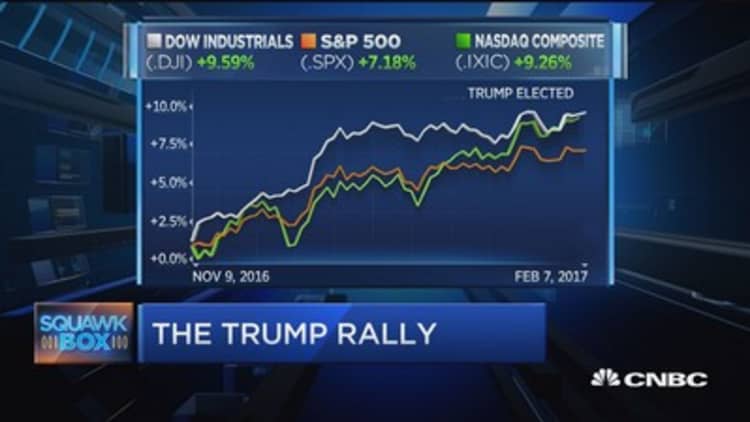Individual investors and market newsletter writers are saying two different things about the market, and that's keeping stocks in a tight trading range — but elevated.
"The extreme sentiment is more of a headwind to further gains, rather than we could head down," said Peter Boockvar, chief market analyst at The Lindsey Group.
The American Association of Individual Investors (AAII) said the percentage of bullish respondents edged up to 35.8 percent, but was still far below the postelection peak of 50 percent that marked a nearly two-year high. Bears fell to 27.7 percent, slightly above the postelection low of 22.1 percent.
On the other hand, this week's Investors Intelligence Advisors Sentiment survey said bulls jumped to their highest since December 2004 at 62.7 percent.
S&P 500 6-month performance
"I think it's somewhat encouraging to see there's a healthy level of skepticism on the markets," said Paul Hickey, co-founder of Bespoke Investment.
"If we can get individual investors back into the market this year," Hickey said, "you could see the bull market trade another leg higher."
Stocks set fresh all-time highs Thursday after President Donald Trump said he would make a big announcement on tax policy in the next few weeks, raising hopes that a highly anticipated tax cut could come soon.

Boockvar said traders are also looking forward to Fed Chair Janet Yellen's congressional testimony next week for indications on how many times the central bank will raise interest rates this year. Tighter monetary policy is generally seen as a negative for stock market gains.
Optimism and pessimism, however, continued to remain in check.
Stock index gains were less than 1 percent on the day, continuing a trend in which the has moved within a 1 percent range from a day's high to low for nearly new months, the longest such stretch on record. Meanwhile, the pressure has remained upward — the benchmark index hasn't fallen more than 1 percent in a single day since October, the longest such streak since 2006.
The CBOE Volatility Index (.VIX), considered the best gauge of fear in the market, remained just above its lowest in a decade.
"No one really trusts the rally, the positive sentiment or the low volatility," Nicholas Colas, chief market strategist at brokerage firm Convergex, said in an email.
"Everyone is waiting for the next shoe to drop," he said. "But without a clear market catalyst for a pullback, we will drift higher."
That said, this time the AAII survey could be right in predicting a downturn ahead.
Mark Arbeter, president of technical analysis firm Arbeter Investments, pointed to declines in the survey's bullish sentiment the spring of 2015 and late 2015 just before major pullbacks in the S&P 500. Optimistic sentiment also trended lower between 2003 and 2007, heading into the market crash in 2008.
AAII bulls (top) and S&P 500 (bottom) from 2004 to 2009
Source: Arbeter Investments.
"Most of the sentiment indicators I look at are pretty frothy right now," Arbeter said. "And with the market at or near an all-time high I think there is some danger here."
Investors Intelligence said the percentage of bears fell to 16.7, the lowest since August 2015. But the difference between bulls and bears is now 46.0 percent, and similar levels haven't been seen since the spring of 2015, just before stocks plunged that summer.


